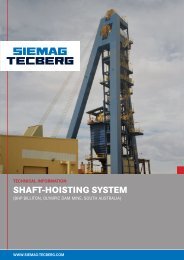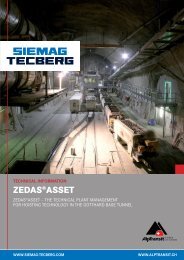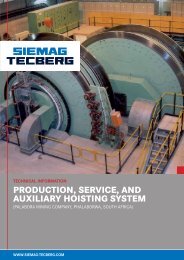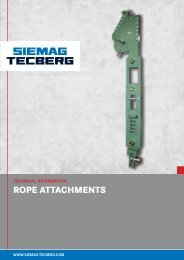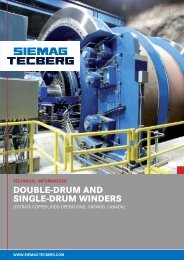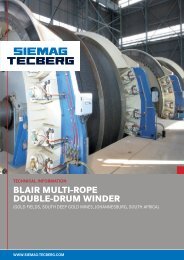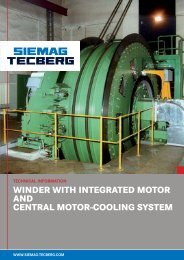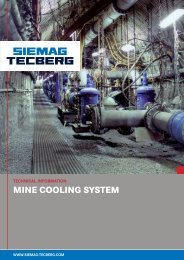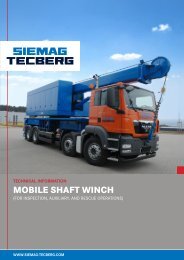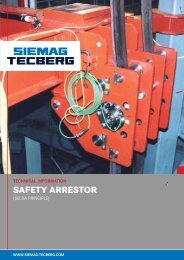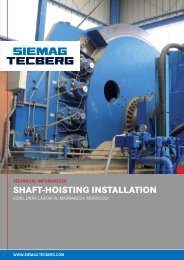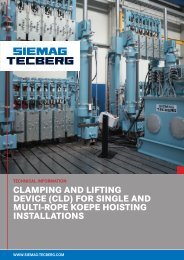TruckLift System
TI_27_Trucklift_e.pdf - Siemag Tecberg
TI_27_Trucklift_e.pdf - Siemag Tecberg
- No tags were found...
You also want an ePaper? Increase the reach of your titles
YUMPU automatically turns print PDFs into web optimized ePapers that Google loves.
SIEMAG TECBERG <strong>TruckLift</strong> slope hoisting<br />
technology<br />
The <strong>TruckLift</strong> <strong>System</strong> is designed for transport on the<br />
natural angle of repose of the open pit mine and can<br />
be lengthened for increasing depth. It is set up as a<br />
single conveyance plant with counterweight, providing<br />
maximum flexibility of the hoisting operation.<br />
It is designed for two or more loading points, one<br />
or more down in the mine and a second one above<br />
at a height appropriate for the purpose. Trucks are<br />
transported on a platform. Down in the mine, the fully<br />
laden trucks drive to the loading station, at which one<br />
vehicle drives onto the transport platform in each<br />
instance. The slope hoisting plant conveys the truck out<br />
of the mine to the upper loading station where it leaves<br />
the plant. The driver stays in his vehicle during hoisting<br />
so that no change of driver is necessary. At the upper<br />
loading station, an empty truck drives onto the platform<br />
for the downward trip immediately after the platform is<br />
free. In this way, the plant runs constantly loaded, each<br />
time a vehicle changes at the loading stations.<br />
The transport platform comprises the platform proper,<br />
on which the truck stops, with pavement, box profiles as<br />
lateral limits, as well as the pertinent sub-construction.<br />
This construction consists of a carrier which overcomes<br />
the offset angle between the horizontal vehicle and the<br />
roadway and where the ropes are hitched. Moreover, the<br />
running gears are attached here which undertake the<br />
carrying and guiding function on the travel path.<br />
The travel path is a concrete or steel construction,<br />
on which the rails for the transport platform and<br />
counterweight are attached. It has appropriate<br />
foundations in the rock. It is designed trough-shaped,<br />
as the counterweight runs under the transport platform.<br />
Rope rollers take over the carrier function for the ropes<br />
on the slope section.<br />
The counterweight is designed as a flat platform with a<br />
running gear to take up the plate weights. What is more,<br />
rope magazines are accommodated here, where on each<br />
some 25 m of rope length can be stored, enabling the<br />
transport distance to be lengthened without rope having<br />
to be changed.<br />
The transport platform and the counterweight are<br />
attached to 6 to 8 ropes and are powered by means of<br />
a multi-rope friction winder. The winder is appointed<br />
in a machine house above the top loading point, rope<br />
sheaves guiding the ropes appropriately. The motor is<br />
appointed in the driving pulley, since the winder is big<br />
enough with regard to diameter and width. The plant<br />
is designed for operation without tail ropes as weight<br />
compensation for the hoisting ropes. In this manner,<br />
there is no equipment necessary at the bottom end<br />
of the hoisting plant, as such equipment would be<br />
expensive to reinstall for a greater depth.<br />
The loading stations comprise the ramps and pertinent<br />
concrete construction in the area between the ramp<br />
and hoisting plant. Platform arrestors are provided at<br />
the loading points, which are run out when the transport<br />
platform arrives, ensuring that the transport platform<br />
is held in position when the load changes by the trucks<br />
arriving and departing. At the same time, this reduces<br />
the dynamic load on the ropes. When the bottom loading<br />
station is transferred, as a result of deeper mining<br />
progression, first of all the new ramps and the civil<br />
construction for the loading station are completed. All<br />
that has to be done now to move the loading station<br />
properly is to transfer the mechanical equipment,<br />
basically the arrestors, and to let out the ropes out of<br />
the magazines. This work can be done in a few shifts.<br />
Truck loading station



